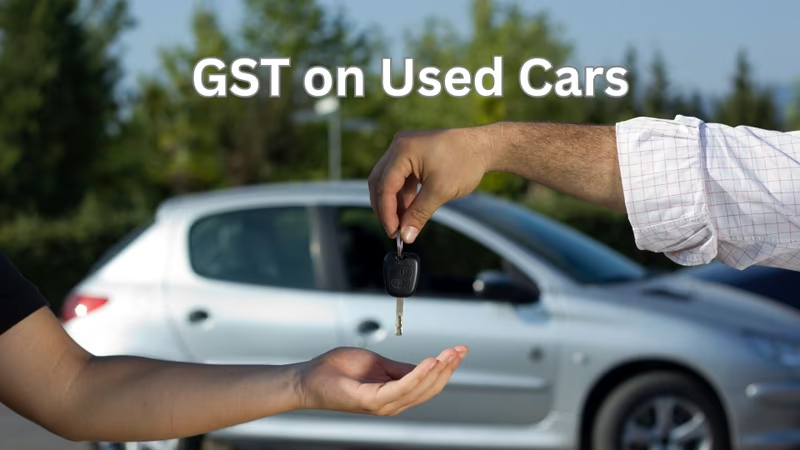The Indian pre-owned car market is a bustling highway of dreams and deals. For many, it is the most practical route to owning a four-wheeler.
However, the journey involves navigating the often-complex lanes of taxation, specifically the Goods and Services Tax (GST).
In 2025, the tax landscape has settled into a more defined structure. Gone are the days of multi-layered rates on used vehicles. A margin-based system is now firmly in place.
This comprehensive guide will steer you through all you need to know about the GST on old cars this year, everything from rates and rules to precise calculation methods.
GST on Old Cars: Meaning & Applicability
Under the GST regime, the sale of used or old cars by a registered person is considered a "supply" and is therefore taxable.
This brings us to the most crucial distinction:
- Sale by a Private Individual: If you sell your personal car to another individual, and you are not in the business of buying or selling cars, GST does not apply. The transaction is not considered to be in the "course or furtherance of business".
- Sale by a Registered Dealer: When a car dealership, a business or any GST-registered entity sells a pre-owned car, the transaction is taxable. These entities are in the business of trading vehicles, making the sale a taxable supply.
Here is a simple breakdown of when GST is applicable:
|
Seller |
Is seller GST-Registered? |
Is buyer GST-Registered? |
GST Applicability |
|
Car Dealer |
Yes |
No/Yes |
Yes |
|
Business (selling its asset, a car) |
Yes |
No/Yes |
Yes |
|
Private Individual |
No |
No/Yes |
No |
How to Calculate GST on Old Cars?
GST is levied on the sale of used cars only when there is a profit. That is, when the selling price exceeds the purchase price or the depreciated value. If sold at a loss, GST is not applicable.
It is a significant relief for the pre-owned car industry. Instead of levying GST on the entire selling price of the car, the tax is applied only to the profit margin earned by the dealer. This is the core principle you need to understand when learning how to calculate GST on old cars.
The margin is calculated as per Rule 32(5) of the CGST Rules. The formula is straightforward:
Margin Selling Price – Purchase Price
The GST is then calculated on this margin.
Let's break it down with a practical example:
A used car dealer buys a car for ₹4,00,000 and sells it for ₹4,75,000.
- Margin = ₹4,75,000 - ₹4,00,000 = ₹75,000
- Assuming a GST rate of 18% on the margin.
- GST Payable = 18% of ₹75,000 = ₹13,500
So, the dealer will pay ₹13,500 as GST to the government.
GST Rate Based on Types of Used Car
In a significant move to simplify the tax structure, 2025 follows a more unified approach. Earlier, the rates for used cars varied (12% or 18%) depending on the car's fuel type and engine capacity.
As of the latest updates for 2025, a uniform GST rate of 18% is applied to the margin for all used vehicles sold by a registered dealer under the margin scheme. This includes petrol, diesel and even electric vehicles.
Here is the simplified GST rate based on the types of used cars:
|
Type of Used Vehicle |
Applicable GST Rate on Margin |
Compensation Cess |
|
All Petrol, Diesel, CNG, LPG and SUV Vehicles |
18% |
Nil |
|
All Electric Vehicles (EVs) |
18% |
Nil |
A key advantage of the margin scheme is the exemption from Compensation Cess. When a dealer sells a used car under this scheme, no compensation cess is levied, which significantly lowers the tax burden compared to new cars.
GST Rules for Used Cars in 2025
Navigating the GST on old cars requires adherence to a specific set of rules. Here are the key GST rules for used cars that every dealer and informed buyer should know in 2025:
- Margin Scheme is Optional: Dealers have the option to use the margin scheme. However, it is almost always the preferred method, as the alternative is to charge GST on the full transaction value, which would make the car uncompetitively expensive.
- No Input Tax Credit (ITC): This is the most important condition for using the margin scheme. The dealer cannot claim an Input Tax Credit on the GST paid on the purchase of the used car or on any refurbishment expenses incurred. If a dealer avails of ITC, they must pay GST on the full sale value.
- Sale by a Company: If a business sells a car that was used as a business asset on which it has claimed depreciation under the Income Tax Act, the margin is calculated differently. The margin will be the difference between the sale price and the written-down (depreciated) value of the car on the date of sale.
- Negative Margin: As established, if the margin on a sale is negative (a loss), no GST is applicable. Dealers cannot set off this loss against the profit from another car sale. Each transaction is assessed individually.
- Documentation is key: Dealers must maintain meticulous records, including purchase and sale invoices for each vehicle, to clearly establish the margin for tax calculation.
Implications of GST for Used Car Dealers
The current GST framework has several direct implications for those in the pre-owned car business. Understanding the implications of GST for used car dealers is crucial for profitability and compliance.
- Simplified Tax Calculation: The uniform 18% rate on the margin simplifies tax computation and reduces classification disputes that were common with the earlier multi-rate structure.
- Working Capital: Since GST is only paid on the profit margin upon sale, it reduces the immediate tax outgo compared to a system where tax is paid on the entire value. This helps in better management of working capital.
- Pricing Strategy: The margin scheme allows dealers to price their cars more competitively. Since the tax component is lower, they can either pass the benefit to the customer or improve their own profitability.
- Compliance Burden: The primary compliance is maintaining accurate records for every single vehicle to justify the margin calculation. Failure to do so could lead to the tax department levying GST on the entire sale value. The restriction on ITC for repair/refurbishment costs also needs to be factored into the final pricing.
- Market Transparency: The clear tax structure promotes greater transparency in the organised used car market, building more trust with consumers.
Learn all about the GST Act from our comprehensive guide.
GST Invoice Format for Old Car Sales
When a dealer sells a used car under the margin scheme, the invoice must be prepared carefully. While it contains standard invoice details (like the dealer's GSTIN, buyer's name, address, etc.), the valuation part is unique.
The invoice should clearly state that the value is calculated under the margin scheme as per Rule 32(5) of the CGST Rules.
The total sale price is inclusive of this tax. A declaration should be added to the invoice stating that GST has been paid under the margin scheme and no ITC has been applied to the purchase.
Use the GST Invoice excel template now.
GST Exemption for Sale of Old Cars
The primary and most widely applicable exemption related to GST on old cars is the sale by an individual for personal reasons. As this does not count as a business activity, it remains outside the purview of GST.
Furthermore, if a used car is sold to an exporter, the transaction may be treated as a zero-rated supply under GST law, meaning no tax is levied, subject to the fulfilment of prescribed conditions and documentation.
GST Compliance Checklist for Old Car Dealers
To stay on the right side of the law, dealers should follow a strict compliance checklist:
- GST Registration: Ensure you are registered under GST if your turnover exceeds the prescribed threshold.
- Proper Invoicing: Issue a valid tax invoice for every sale, with a specific declaration about the margin scheme.
- Accurate Record-Keeping: Maintain separate, detailed records for each vehicle's purchase price, refurbishment costs and selling price.
- GST Returns: Report the taxable value (i.e., the margin) and the GST paid in your monthly/quarterly GSTR-1 and GSTR-3B returns correctly.
- No ITC Claims: Do not avail ITC on the purchase of used cars or the inputs/services used for their repair if you are opting for the margin scheme.
- Annual Returns: File the annual GST return (GSTR-9) and reconciliation statement (GSTR-9C) as applicable.
Challenges in GST on Used Cars
Despite the simplification, some challenges remain. Valuation can sometimes be tricky, especially when dealing with cars acquired through auctions or from unregistered individuals, where documentation might be inconsistent.
Ensuring that every expense related to refurbishment is correctly mapped to the vehicle's cost price requires robust accounting systems.
Download the Jar app and start investing smartly with digital gold.
Final Word
The journey of GST on old cars has moved towards a more stable and predictable way in 2025. The implementation of a universal 18% profit margin rate has eliminated ambiguity and established a fair and equitable environment for dealers.
This structure supports the growth of the organised used-car market by making compliance simpler and pricing more transparent.
For dealers, the key to success lies in meticulous documentation and a thorough understanding of the margin scheme.
For buyers, purchasing from a GST-compliant dealer offers peace of mind and assurance of a transparent deal.
Frequently Asked Questions
1. How to calculate GST on old cars sold by dealers?
GST is calculated on the profit margin. First, determine the margin by subtracting the car's purchase price (including any refurbishment costs) from its selling price. Then, apply the 18% GST rate to this margin.
2. What is the GST rate for SUVs in used condition?
As of 2025, the GST on old cars is a uniform 18% on the profit margin for all vehicle types, including SUVs, when sold by a registered dealer under the margin scheme. No additional compensation cess is applicable.
3. Are private individuals liable to pay GST when selling their cars?
No. If an individual sells their personal car, it is not considered a business transaction. Therefore, the sale is not subject to GST. This is the most significant exemption under the rules for GST on old cars.
4. What are the GST rules for used car dealers?
The main GST rules for used car dealers revolve around the margin scheme. Key rules include:
- Pay 18% GST only on the profit margin (selling price - purchase price).
- Do not claim Input Tax Credit (ITC) on the vehicle purchase or related expenses.
- Pay no GST if a car is sold at a loss.
- Maintain detailed purchase and sale records for each vehicle.
5. Is ITC available when dealing with used vehicles?
No, a dealer cannot claim an Input Tax Credit (ITC) when purchasing a used car if they want to benefit from the margin scheme (i.e., pay GST only on the profit).
This is a mandatory condition. If a dealer chooses to claim ITC, they must charge GST on the full selling price of the car, not just the margin.










